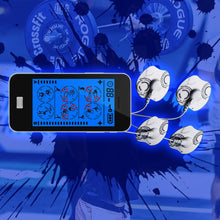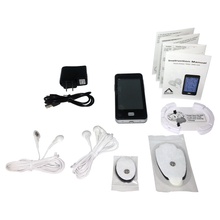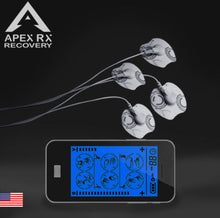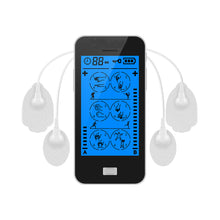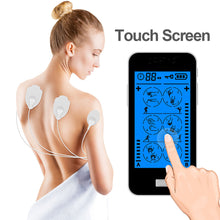
- TENS EMS Combo Unit < < FDA cleared TENS and EMS combined physical therapy equipment, provides a safe, non-invasive and drug-free method for pain management. Such as sufferers of Tennis Elbow, Carpal Tunnel Syndrome, Arthritis, Bursitis, Tendonitis, Plantar Fasciitis, Sciatica, Back Pain, Fibromyalgia, Shin Splints, Neuropathy, and other Inflammation Ailments
- Simultaneously Use to Any Body Parts < < 24 MODES - Supports dual outlets to control 4 electrode pads at the same time and simultaneously used by two people. Can be used on various body parts, such as back, neck, knee, shoulders, legs, arms, feet, etc.
- Touchscreen Easy to Operate < < Digitally animated touch screen allows perspicuous and easy control of 24 different massage modes and 20 adjustable intensity level for optimal body massaging
- Safety Guaranteed < < Timer function supports auto-off; Smart screen lock effectively avoids any misoperation; Light up LCD Screen
- Fast 30-mins USB Recharging < < Charge 30 minutes (namely 12 hours of continuous use); pocket-size, micro USB charging, and dual voltage are especially convenient no matter for home or travel use.
Apex Rx EMS/ TENS COMBO Unit
Generates and sends electrical signals, via electrode pads, to your muscles, causing them to twitch or contract, in turn
- Improve joint pain and swelling.
- Breaks down lactic acid build up in muscles.
- Prevents and reverses muscle atrophy (loss of muscle mass/tissue)
- Enhances rehabilitation of muscles.
- Increases range of motion.
- Reduces stress and discomfort.
- Improves blood flow and circulation.
EMS can temporarily strengthen, tone, or firm muscles to some extent, it will not cause long-term improvements in health and fitness, according to the FDA. So we highly recommend pairing this device with your standard exercise routine.
In order to obtain the best degree of pain relief with Apex Rx Recovery TENS, we recommend the following TENS pad placement guidelines:
Directions:
Take note of exactly where your pain is located. Outline the most concise and tender area of the pain.
Always use two pads at the same time.
You can alter the flow of the electrical sensation if you change the distance between the electrode pads and/or the direction of the pads.
The pads can be placed in one of three directions 1. vertical 2. horizontal 3. angulated.
The pads should never touch and should be at least, 1 inch apart. As the distance between the two pads increases the effectiveness decreases.
It is advisable not to place the pads directly over a joint such as the knee, elbow or ankle as its movement can alter the adherence of the pad.
Here’s some advice on which direction to place the pads:
When the pain extends across a significant distance of your body (e.g. low back to just above the back of the knee): Place one of the pads vertically at the top of the pain and the other pad vertically at the bottom of the pain.
When the pain is more focused over a smaller area (e.g. calf pain): Place pads in parallel on each side of the pain.
When the pain overlaps a joint (e.g. elbow pain): Place each pad on the muscle or soft tissue just above and below the joint in a horizontal and parallel direction.
When the pain is wide (e.g. between your shoulders below the neck): Place the pads to the left and right side of your spine in a vertical direction. If pain extends out even further above or below the shoulder area, the pads can be angulated to encompass the region of discomfort.
Never Use If:
Cardiac simulator (pacemaker), implanted defibrillator or other implanted metallic or electronic device. Such use could cause
electric shock, burns, electrical interference • or death.
• Epilepsy.
• Cancer or cancerous lesions. •
• Any heart problem or condition.
• Pregnancy
• (do not use over the abdominal area).
• Serious arterial circulation disorders in
lower limbs.
• Abdominal or inguinal hernia.
Don't Use if you have ANY of the following:
Muscle atrophy.
After trauma or a recent operation
• Do not apply stimulation in bath or shower. •
• Do not use EMS in an oxygen-rich atmosphere.
• Do not connect leads or pads to the other objects. •
• During a stimulation session, do not disconnect electrodes when stimulation is running. Stop the stimulation first.
• Do not use the PowerDot while driving, • operating machinery, cycling or during
any activity in which electrical stimulation • can put you at risk of injury. •
• Do not apply stimulation while sleeping. • Do not allow movement resulting from muscular contraction during a
stimulation session.
Please Consult a Physician if you have additional questions.
FAQ
How does E.M.S. work?
In order for a muscle to contract, your brain has to send an electrical impulse to neurons in muscle fibers. EMS basically mimics what your brain does in this scenario: By applying electrode pads to different parts of a muscle, trainers can send a small electrical impulse to a muscle that tells it to contract. (That's why EMS is particularly useful for people who have experienced an injury or have had a stroke and need to "re-teach" their brain how to activate a muscle.)
Does it hurt?
Most people say that the first time you do it feels odd. It doesn’t hurt, necessarily, but it feels like a pulse or buzz like somebody’s flicking you with a rubber band. Some people say that it feels More like a vibration. Despite the catchy name, the electricity and shock you'd typically experience during an EMS workout is pretty minimal. It's not enough electricity to start a car or run a battery.









